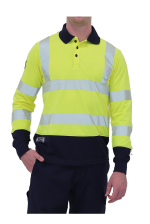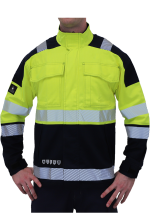Cal Ratings for ARC protective Clothing
What Is the Difference Between ATPV, Ebt and ELIM?
Arc Thermal Performance Value (ATPV) is “the incident energy on a fabric or material that results in sufficient heat transfer through the fabric or material to cause the onset of a second degree burn based on the Stoll curve. The level of protection provided by flame resistant clothing as measured in cal/cm2. An arc rating (ATPV) means that you have a 50% chance of being burned if exposed to an electric arc with the same number of calories of heat. The fabric will usually not break open unless exposed to energy levels higher than the arc rating.
Ebt is similar to ATPV but is determined when break-open occurs before the onset of a second degree burn. Energy breakopen threshold (Ebt) is “the average of the five highest incident energy exposure values below the Stoll curve where specimens do not exhibit breakopen. An arc rating (Ebt) means that the garment will break open if exposed to the same number of calories, but you will not be burned.
All FR fabrics will break-open if exposed to sufficient energy. If an arc rated fabric is exposed to energies higher than its break-open value, the potential for direct skin exposure or non-FR inner layer ignition may result in additional injuries.Important factors influencing a protective systems arc rating (ATPV, Ebt or ELIM) are the fabrics weight, construction, and fibre make-up.
Because PPE Regulation (EU) 2016/425 states that Personal Protective equipment shouldn’t bring any harm to the wearer which conflicts with APTV calculation of a 50% chance of harm to the wearer, therefor ELIM (Energy Limit Value) was created and is calculated by the highest level of energy with a 0% chance of break open or second degree burn.
ATPV, Ebt and ELIM are evaluated in the same test, EN61482-1-1 & ASTM F1959 in America , but the first one to be reached is the reported arc rating. While both values (ATPV and Ebt) can be reported, only one arc rating is given to fabric. Only the lowest value will be used on the clothing label.
If an Ebt value is determined and found to be equal or below a determined ATPV value, then the Ebt value is reported as the arc rating and will be noted as “Arc Rating (Ebt)” on the garment label. Ebt fabrics are typically more insulative than they are strong, and generally ATPV fabrics are stronger than they are insulative.










